
57
MIXASSIST & DUGAN AUTOMIXING
5
Assigning Inputs to the Auto Mixer
Inputs that are assigned to an Auto Mixer (MixAssist or Dugan) are referred to
as active automixed inputs and will be included in the mix. Inputs not assigned
to the Auto Mixer are referred to as inactive automixed inputs and will not be
included in the mix.
To assign inputs to MixAssist or Dugan AutoMix:
1. Access the Auto Mixer screen.
2. Turn the Select encoder to move the orange highlight vertically down to the
Input Selection section.
3. Turn the Headphone encoder to move the orange highlight horizontally.
4. With the orange highlight positioned on the selected source, press either
encoder to change the selected input to either Not Assigned (black) or
Assigned (blue).
L
Inputs that are routed post-fader to the L or R bus and do not have Auto Mixer
activated will not be auto-mixed but will still be analyzed by MixAssist for the
purposes of Last Mic Lock-On, One Mic Per Sound Source, and Number of Open
Mics Attenuation.
Overview of MixAssist
The Sound Devices MixAssist feature auto-mixes post-fade input signals to the
left (L) and right (R) buses. Other signals are not affected by MixAssist.
MixAssist does not limit the number of open microphones and will allow several
microphones to be open simultaneously if there are several talkers. MixAssist
also intelligently attenuates redundant mics that are picking up the same sound
source, which signi
fi
cantly helps to reduce comb
fi
ltering and phasing artifacts.
Inputs that are automixed will be open (unattenuated) when a person talks into
the input’s microphone and closed (attenuated) when the person stops talking.
Microphone channels open with ultra-sensitive responsiveness to voice levels to
ensure that no syllables are lost, and then will “gate off” smoothly over 500mS.
This gating action is smooth and imperceptible when switching between micro-
phones. MixAssist is more sophisticated than a simple gate, and uses four dif-
ferent principles to automix input signals: noise adaptive threshold, one mic per
sound source, number of open mic attenuation, and last mic lock-on.
















































